Address:Floor2,Build B,Sanmin Industrial Zone,Shilongzai,Shiyan sub-district,Baoan District,ShenZhen,China
Product Features
Microcomputer IC controls charging process: CC/CV/Trickle charging, to make sure the battery is full charged and won’t be over charged; four slots control independently by touch; Mixed charging mode.
Color LCD instantly shows the charging process, battery voltage, current , time, capacity, charge curve, discharge curve and internal resistance.
Applicable batteries
Compatibility: various kinds of cylindrical chargeable batteries (Diameter: below 32mm, height: 34-73mm)
Charge : Li-ion3.7V, Li-ion3.8V, FiFePO4, Ni-MH/Cd batteries.
AC 110V-250V/ DC 12V input (or DC12V 5A vehicle input).
Charging, Discharging, Capacity Test and Internal resistance.
Four types of charging current: 0.5A, 1.0A, 1.5A, 2.0A. (According to different capacity)
Discharging current: 0.5A.
Reverse connection protection: when the battery is reversed, the corresponding slot battery icon shows ‘Battery Error’.
Short circuit protection: when the battery is short circuit, the corresponding slot battery icon shows ‘Battery Error’.
Activate automatically for Li-ion batteries with protection board, which are instantaneous short circuit.
Intelligent temperature control: the built-in cooling fan will automatically open when the internal temperature of the machine rises to 60 degrees Celsius according to two temperature sensors. When the temperature drops by 40 degrees Celsius, it stops automatically to ensure that the charger has a good working condition; avoiding high capacity battery that is overheated during the charge and discharge process, causing spontaneous combustion or ignition.
Interface specification & Operation specification
4.1The Main Interface specification
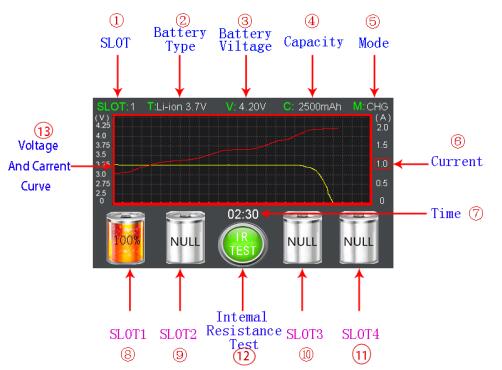
①Slot status: Displaying the slot is selected when the battery is connected.
②Battery Type Status: Displaying battery type is currently selected in this slot (Li-ion3.7V, Li-ion3.8V, LiFePO4,Ni-MH/Cd).
③Battery voltage status: Displaying the current actual voltage of the battery in this slot.
④Capacity status: Displaying the real-time capacity of the currently selected charge/discharge status of the selected battery in this slot.
⑤Mode status: Display the status of the battery is currently selected in this slot(Charge,Discharge,Capacity Test).
⑥Current status:Displaying the current of the battery is selected in this slot.
⑦Time status: Showing the time when this slot is selected to access the battery and the mode is completed in the selected mode.
⑧The SLOT 1: If this icon is selected, the battery icon will turn red. When it is not selected, the battery icon will be green. When the slot is selected, click the icon again to enter the settings interface of the slot. As shown in the following figure below:
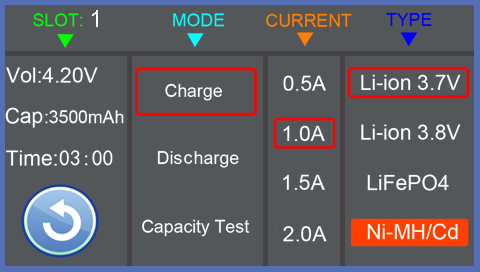
⑨The SLOT 2: Selecting this icon,the battery icon will be red, and green when not selected.
⑩ The SLOT 3: Selecting this icon, the battery icon will be red, and green when not selected.
⑪ The SLOT 4: Selecting this icon, the battery icon will be red, and green when not selected.
⑫ Internal resistance test button: Clicking the icon to enter the internal resistance test interface as follows:
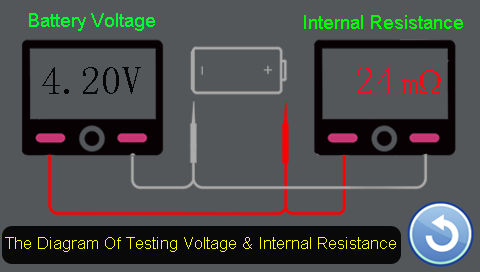
Access the matching test pens. The red lead is connected to the positive pole of the battery and the black lead to the negative pole of the battery. Waiting for 3 seconds to obtain the actual voltage and internal resistance.(Note: After the charger is connected to the power supply, please do not test what the battery is charging in the charger, so as not to damage the internal resistance test circuit caused by the bad contact peak voltage. It is recommended to test the battery resistance after removing the battery. Voltage range: 5V max the range of internal resistance: 0~255mΩ)
⑬ Curve: The voltage and current curves of the battery in the selected slot are displayed. The progress of the curve has an auto-scaling function. The red line is the voltage curve and the yellow line is the current curve.
4.2 The Settings interface specification
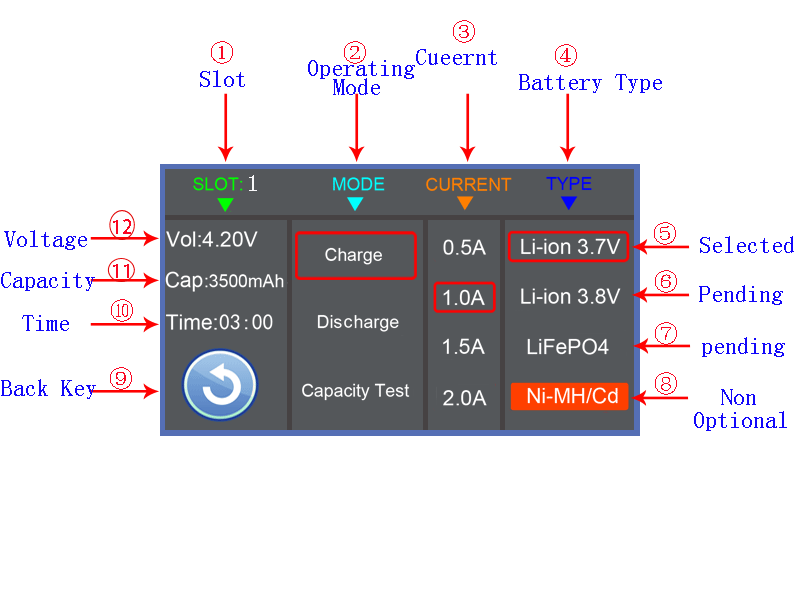
Access multiple batteries and click on the battery icon to switch curves, the battery icon is selected that will turn red , and then, clicking the red battery icon again to enter the settings interface. As shown in the following figure below:
① Displaying current slot information
② Operating mode: There are three modes: Charge, Discharge and Capacity Test; The default mode is Charge.
③ Current selection: There are four kinds of currents will be selected, that is 0.5A, 1A, 1.5A and 2.0A; Li-ion and LiFePO4 default to 1.0A; Ni-MH defaults to 0.5A.
④ Battery type: It will automatically identify NiMH batteries and Li-ion batteries when the battery is put . When a Li-ion battery is detected, the Li-ion 3.7V charging program is selected by default, at this time Ni-MH/Cd option is red, that it is not selected. A high-capacity 3.8V battery or a LiFePO4 battery needs to be switched to the corresponding program Li-ion 3.8V or LiFePO4 by hand; when an Ni-MH/Cd battery is detected, the other three options are red, which not selected.
⑤ Selected state: The red rounded rectangle will appear when selected.
⑥
⑦ Pending state
⑧ Non-optional state: This status is red when the function cannot be selected.
⑨ Back key: Selecting the button to return to the main interface.
⑩ Time: Displaying the function operating time of the current slot.
⑪ Capacity: Displaying the capacity value of the current slot Charge, Discharge or Capacity Test.
⑫ Voltage: Displaying the real-time voltage of the current slot.
NOTE:
* Selected icon will display a red border.
* Ni-MH battery can not select the battery type, the other three battery type icons are the whole red that is not optional when the NI-MH battery is identify.
* Ni-MH charging current can only be selected when the battery is just inserted, after selecting current it will not be able to change the other current, at this time the other current icon to become the whole red that is not optional.
* The three kinds of the MODE menu (Charge, Discharge, Capacity) can switch any state.
4.3 The Internal Resistance Test interface specification
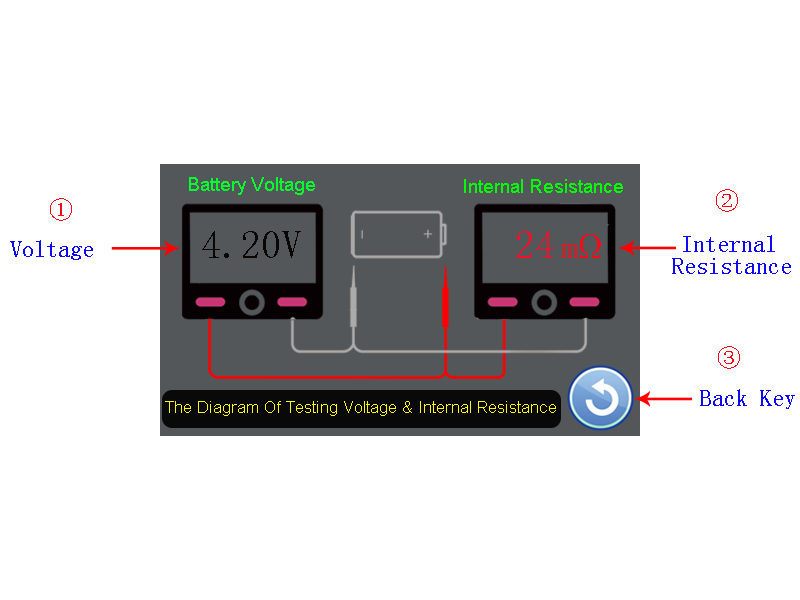
①Displaying the voltage value of the battery being tested.
②Displaying the internal resistance value of the battery being tested.
③Back key: Clicking the button to return to the main interface.
4.4 Operation specification
1)The AC side of the power adapter access to the mains, and the output side access to the charger.
2)After the power is turned on, the company's logo is displayed on the color screen in the form of the sea, which(HAOBA Company) represents the warm greetings and blessings to the global users.
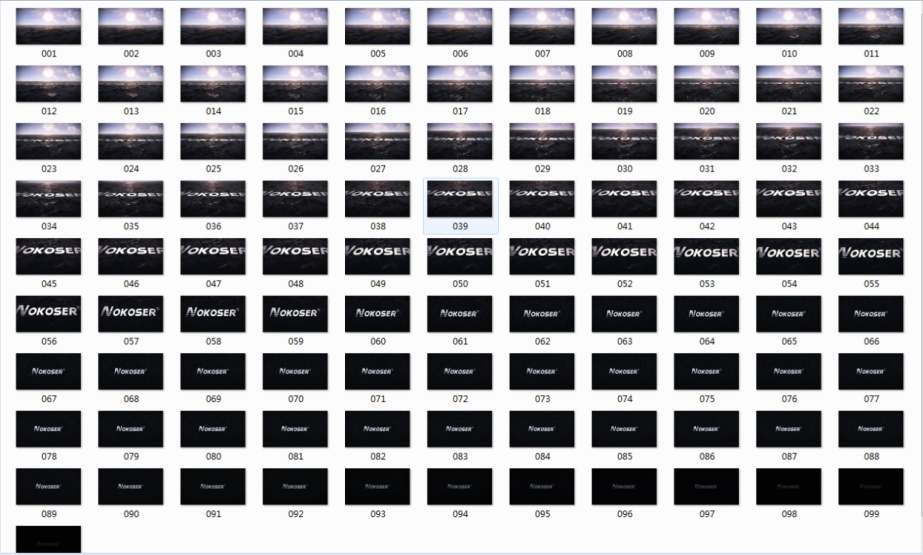
After booting, displaying the following figure:
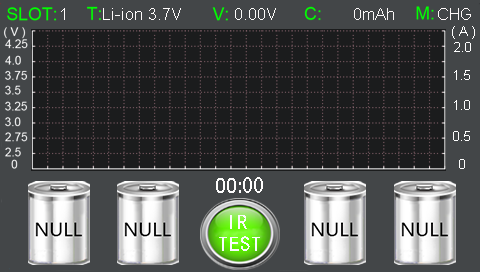
3)Accessing battery,displaying the following figure:
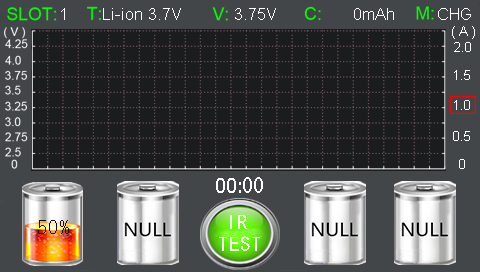
After the battery is connected and waited for 5 seconds. If the user clicks into the setting interface within 5 seconds, it will work according to the user setting parameters. Otherwise, the slot will automatically enter the default charging mode.
4) Switching Battery information
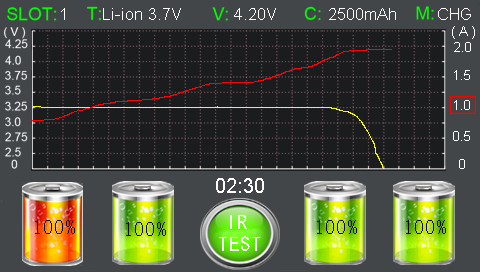
If user click on the battery icon what user want to view after accessing multiple batteries, the battery icon of the group turns red, and all the information at the top of the main interface is the information of the selected slot.
5)Change settings:
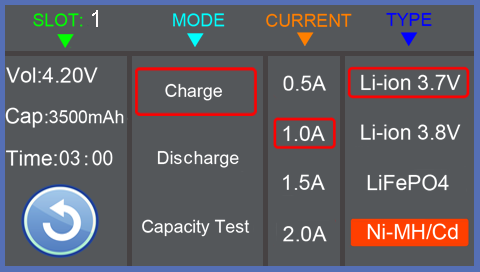
If the user wants to change the setting, there are two ways:
① When the battery is waiting for 5 seconds, and clicking the battery icon. (Note: Ni-MH battery charge current must be within 5 seconds, if there is no operation after 5 seconds, then charge with the default current; it can not change the current during charging).
② Selecting the battery icon that user want to set the slot during the charging process. Clicking the battery icon again to enter the setting interface.
3.Electric Features:
Input: AC100-240V 50/60Hz DC 12V 5A
Output:
Li-on 3.8V :
Charging: Constant current and constant voltage
Discharging: Constant current
Cutoff voltage: 4.35±0.02V
Cutoff voltage: 2.85±0.02V
Discharging current: 0.5A * 4
Recharging current:
0.5A ±30mA
1.0A ±50mA
1.5A ±60mA
2.0A ±80mA
Cutoff current:≤75mA
Li-on 3.7V :
Charging: Constant current and constant voltage
Discharging: Constant current
Cutoff voltage: 4.20±0.02V
Cutoff voltage: 2.75±0.02V
Discharging current:0.5A * 4
Recharging current:
0.5A ±30mA
1.0A ±50mA
1.5A ±60mA
2.0A ±80mA
Cutoff current:≤75mA
LiFePO4 3.2V :
Charging: Constant current and constant voltage
Discharging: Constant current
Cutoff voltage: 3.60±0.02V
Cutoff voltage: 2.0±0.02V
Discharging current:0.5A * 4
Recharging current:
0.5A ±30mA
1.0A ±50mA
1.5A ±60mA
2.0A ±80mA
Cutoff current:≤75mA
Ni-HM/Cd :
Charging: Pulsed constant current
Discharging: Pulsed constant current
Cutoff voltage: 1.43±0.02V
Cutoff voltage: 0.9±0.02V
Discharging current:0.5A * 4
Recharging current:
0.5A ±30mA
1.0A ±50mA
1.5A ±60mA
2.0A ±80mA
Maximum voltage: 1.53V
-△V:5mV
Prev:Data updata!
Next:4H-LCD-D